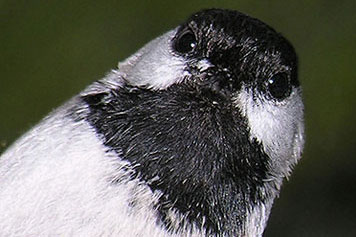Chickadees
Chickadees are small, mainly grey-and-black birds with a short strong bill and strong legs. They feast on seeds and insects. They, and their relatives, are also known as tits (meaning, small) and titmice (meaning, small bird).
 An intarsia of a Black-capped Chickadee by local artist, Gail Burton.
An intarsia of a Black-capped Chickadee by local artist, Gail Burton.
The name, chickadee, comes onomatopoetically from their distinctive song. Many species will live around human habitation and come readily to bird feeders.
 A Black-capped Chickadee comes in for a landing. Although most song birds confine their singing to breeding season, the Black-capped chickadee delights its fans by singing throughout the year.
A Black-capped Chickadee comes in for a landing. Although most song birds confine their singing to breeding season, the Black-capped chickadee delights its fans by singing throughout the year.
 The Chestnut-backed Chickadee is the smallest of the chickadees. While the Black-capped Chickadee is found across southern Canada, the Chestnut-backed Chickadee is largely confined to the rainforest of the Coast and Kootenays of British Columbia.
The Chestnut-backed Chickadee is the smallest of the chickadees. While the Black-capped Chickadee is found across southern Canada, the Chestnut-backed Chickadee is largely confined to the rainforest of the Coast and Kootenays of British Columbia.
 The Black-capped Chickadee is a woodland bird.
The Black-capped Chickadee is a woodland bird.
 The Black-capped Chickadee readily adapts to humans and is a frequent visitor at bird feeders. Its distinctive call, chick-a-dee-dee, gives the bird its name, but many words with that same rhythm can be used. Some imagine that it is calling, hey sweetie, while others have called it the cheeseburger bird.
The Black-capped Chickadee readily adapts to humans and is a frequent visitor at bird feeders. Its distinctive call, chick-a-dee-dee, gives the bird its name, but many words with that same rhythm can be used. Some imagine that it is calling, hey sweetie, while others have called it the cheeseburger bird.
 This Chestnut-backed Chickadee has just taken flight from a perch. Despite the almost eagle-like look of this picture, this is really quite a small bird: its wingspan is about 19 cm.
This Chestnut-backed Chickadee has just taken flight from a perch. Despite the almost eagle-like look of this picture, this is really quite a small bird: its wingspan is about 19 cm.
 This Black-capped Chickadee carries a sunflower seed away in its beak. The wings show a double image: both the top and bottom of the stroke. As the wings briefly stop at each end of a stroke, this is when an image is recorded.
This Black-capped Chickadee carries a sunflower seed away in its beak. The wings show a double image: both the top and bottom of the stroke. As the wings briefly stop at each end of a stroke, this is when an image is recorded.
 A Chestnut–backed Chickadee looks for seeds on a conifer.
A Chestnut–backed Chickadee looks for seeds on a conifer.
 This Chestnut-backed Chickadee looks for food in a open pond in December.
This Chestnut-backed Chickadee looks for food in a open pond in December.
 It behaves almost like a dipper as it scours the pond.
It behaves almost like a dipper as it scours the pond.
Information from Wikipedia: Black-capped Chickadee.
![]()